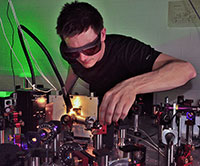Sep 2 2015
A group of physicists from the University of Kaiserslautern, Bielefeld University and the University of Würzburg have shown that when light is efficiently scattered in rough, ultrathin films, it is completely absorbed.
 Dominik Differt measuring the scattering of light in a rough absorber film. Photo: Bielefeld University
Dominik Differt measuring the scattering of light in a rough absorber film. Photo: Bielefeld University
This latest finding could help to make thin absorber films more efficient, which would result in more energy savings.
Films which absorb light are used in a wide range of applications such as sensor and solar cells. Such films trap the light accurately and are mainly used for changing light into electrical heat/current. While light-absorbing films are extensively used, it is still not clear as to which mechanism allows for efficient light absorption.
The researchers performed experiments, where ultrashort light pulses were applied. These light pulses enter into smooth, ultrathin films and come out from the other side of the films without becoming weak or experiencing any significant changes.
However, in the case of rough films, the light pulse is not able to spread across the material as a result of irregularities. When too many irregularities lead to scattering of light, the pulse moves along a closed path and continues to remain trapped until the light is fully absorbed.
The researchers confirmed this light trapping mechanism by means of two effects. In the first effect, a tiny portion of the trapped light was allowed to spread out of the absorber layer. When the intensity of this scattered light is tracked over time, the time it takes the light to remain trapped in the film can be directly observed. The second effect provides data about the local absorption of energy and spatial localization of the trapped light.
When ultrashort light pulse is absorbed, electrons in the absorber material get excited and are briefly heated to several thousand degrees Celsius temperature, which are similar to the temperature found on the sun’s surface. Under these high-temperature conditions, the material emits electrons, which can be validated with high-resolution electron microscopy.
Measurements demonstrate that the light gets absorbed in small regions measuring less than 1µm diameter, and this is where the light also gets absorbed. This phenomenon is called Anderson localization, whose fundamental effect was described over six decades ago and since then has been observed a number of times. This mechanism also works for thin absorber layers.
"This opens up new ways to develop highly efficient absorbers and can therefore contribute to developing improved thin-film solar cells or sensors," said Professor Dr. Walter Pfeiffer from Bielefeld University.
The aim of this study is to develop more efficient thin-film absorbers so that they can be applied in routine applications. In future studies, the physicists intend to explore the type of structure that can be used by films to promote efficient light trapping and then apply this idea to develop a common concept of efficient absorption of light through Anderson localization.
The study has been published in the journal Nature Photonics.